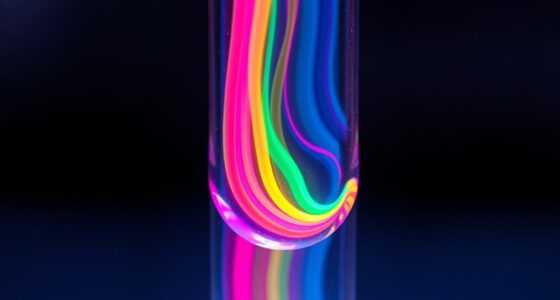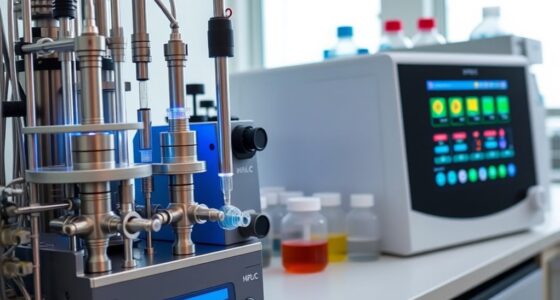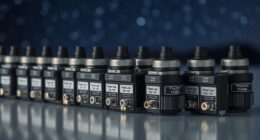Electrochemical sensors can detect toxins in just a single drop by converting chemical reactions into electrical signals with high sensitivity. They use biocompatible materials and nanomaterials like gold nanoparticles or carbon nanotubes to amplify signals and detect even trace levels of harmful substances quickly. These sensors are compact, durable, and suitable for real-time applications, making toxin detection faster and more accessible. Keep exploring to discover how these advanced sensors revolutionize safety and health monitoring.
Key Takeaways
- Electrochemical sensors can detect toxins in minute sample volumes, often from just a single drop of fluid.
- Biocompatible materials ensure safe, accurate toxin detection in biological samples like blood or saliva.
- Nanomaterials enhance signal amplification, enabling the detection of trace toxin levels with high sensitivity.
- Material selection and environmental stability are vital for maintaining consistent sensor performance over time.
- Advanced materials allow for miniaturized, portable sensors suitable for real-time, on-site toxin monitoring.

Electrochemical sensors are devices that detect chemical substances by measuring electrical signals generated during chemical reactions. They’re highly sensitive tools capable of identifying toxins, biomarkers, and other analytes in minute quantities, often from just a single drop of fluid. This sensitivity hinges on the careful selection of materials and design strategies that optimize the sensor’s performance. One vital aspect of their design involves the use of biocompatible materials. These materials ensure that the sensors can interact safely with biological samples, such as blood or saliva, without causing adverse reactions.
By incorporating biocompatible components, you can develop sensors suitable for real-time, in vivo monitoring, making them invaluable for medical diagnostics and environmental testing. Color accuracy is also essential in the development of electrochemical sensors, as it impacts the clarity and reliability of visual data interpretation.
Another key factor that enhances the capabilities of electrochemical sensors is signal amplification. When detecting trace amounts of toxins, the electrical signals generated by the chemical reactions can be weak, making them challenging to measure accurately. Signal amplification techniques, such as using nanomaterials like gold nanoparticles or carbon nanotubes, can markedly increase the electrical response. These materials boost the signal strength, allowing you to detect even the tiniest concentrations of harmful substances with high precision. Additionally, material selection plays a crucial role in ensuring that the sensor maintains optimal performance under various environmental conditions.
Combining biocompatible materials with effective signal amplification strategies results in sensors that are both safe for biological environments and highly sensitive, guaranteeing reliable detection from a single drop of fluid.
The integration of biocompatible materials and signal amplification techniques also improves the sensor’s stability and longevity. When you design sensors with durable, biocompatible components, they can operate effectively over extended periods without degradation. This durability is essential for continuous monitoring applications where consistent, accurate readings are critical.
Moreover, the miniaturization enabled by advanced materials allows you to create compact, portable sensors that can be easily used in the field or integrated into wearable devices. Such portability expands the potential applications of electrochemical sensors, making toxin detection more accessible and faster than traditional laboratory methods.
Frequently Asked Questions
How Long Do Electrochemical Sensor Measurements Typically Take?
You’ll find that measurement duration for electrochemical sensors usually ranges from a few seconds to a few minutes, depending on the application.
During this time, sensor calibration is essential to guarantee accuracy. Proper calibration minimizes errors, making your measurements more reliable.
Typically, the process is quick, allowing you to get results promptly, often within 30 seconds to 2 minutes, making these sensors ideal for rapid toxin detection in a single drop.
Are Electrochemical Sensors Reusable or Single-Use?
You might wonder if electrochemical sensors are reusable or single-use. Generally, they can be reusable if properly calibrated and maintained.
However, some are designed for single-use to guarantee accuracy. Sensor calibration is vital for reliable results, and their shelf life affects how long they stay effective.
Always follow manufacturer instructions to maximize their lifespan and performance, whether you’re reusing or discarding them after a measurement.
What Are the Limitations of Electrochemical Toxin Detection?
You might think electrochemical toxin detection is flawless, but it’s not. The main limitations include a limited sensor lifespan that restricts long-term use, and calibration challenges that can skew results.
These issues can cause inaccuracies and make it difficult to rely on a single sensor for consistent, precise measurements over time. Despite their sophistication, these sensors still face hurdles in delivering reliable, sustained performance in real-world applications.
How Do Environmental Factors Affect Sensor Accuracy?
You should consider how environmental factors influence sensor accuracy. Temperature interference can cause fluctuations in sensor readings, leading to false positives or negatives.
Humidity effects may affect the sensor’s surface and its ability to detect toxins accurately. When using sensors outdoors or in variable conditions, these factors can compromise results, so calibration and protective measures are vital to guarantee reliable toxin detection despite environmental challenges.
Can Electrochemical Sensors Detect Multiple Toxins Simultaneously?
Imagine a future where you can identify multiple toxins at once—this is possible with multiplex detection in electrochemical sensors. By integrating various sensing elements, these sensors can simultaneously detect different toxins, saving time and ensuring safety.
With advanced sensor integration, you have a powerful tool that offers rapid, accurate, and extensive analysis, transforming how we monitor environmental and health hazards.
Conclusion
Imagine your single drop of water as a tiny lighthouse, guiding you through the darkness of unseen toxins. Electrochemical sensors act as the vigilant lighthouse keeper, illuminating dangers before they reach you. With each test, you harness the power of these sensors, turning a simple drop into a beacon of safety. Together, they symbolize hope and precision, ensuring that even the smallest quantities are detected, so you can protect what matters most with confidence and clarity.









